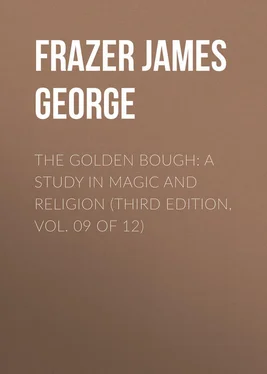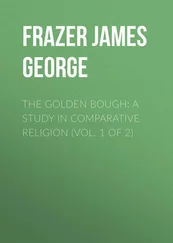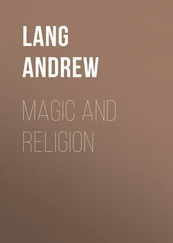James Frazer - The Golden Bough - A Study in Magic and Religion (Third Edition, Vol. 09 of 12)
Здесь есть возможность читать онлайн «James Frazer - The Golden Bough - A Study in Magic and Religion (Third Edition, Vol. 09 of 12)» — ознакомительный отрывок электронной книги совершенно бесплатно, а после прочтения отрывка купить полную версию. В некоторых случаях можно слушать аудио, скачать через торрент в формате fb2 и присутствует краткое содержание. Жанр: foreign_religion, foreign_antique, foreign_prose, на английском языке. Описание произведения, (предисловие) а так же отзывы посетителей доступны на портале библиотеки ЛибКат.
- Название:The Golden Bough: A Study in Magic and Religion (Third Edition, Vol. 09 of 12)
- Автор:
- Жанр:
- Год:неизвестен
- ISBN:нет данных
- Рейтинг книги:3 / 5. Голосов: 1
-
Избранное:Добавить в избранное
- Отзывы:
-
Ваша оценка:
- 60
- 1
- 2
- 3
- 4
- 5
The Golden Bough: A Study in Magic and Religion (Third Edition, Vol. 09 of 12): краткое содержание, описание и аннотация
Предлагаем к чтению аннотацию, описание, краткое содержание или предисловие (зависит от того, что написал сам автор книги «The Golden Bough: A Study in Magic and Religion (Third Edition, Vol. 09 of 12)»). Если вы не нашли необходимую информацию о книге — напишите в комментариях, мы постараемся отыскать её.
The Golden Bough: A Study in Magic and Religion (Third Edition, Vol. 09 of 12) — читать онлайн ознакомительный отрывок
Ниже представлен текст книги, разбитый по страницам. Система сохранения места последней прочитанной страницы, позволяет с удобством читать онлайн бесплатно книгу «The Golden Bough: A Study in Magic and Religion (Third Edition, Vol. 09 of 12)», без необходимости каждый раз заново искать на чём Вы остановились. Поставьте закладку, и сможете в любой момент перейти на страницу, на которой закончили чтение.
Интервал:
Закладка:
James George Frazer
The Golden Bough: A Study in Magic and Religion (Third Edition, Vol. 09 of 12)
Preface
With The Scapegoat our general discussion of the theory and practice of the Dying God is brought to a conclusion. The aspect of the subject with which we are here chiefly concerned is the use of the Dying God as a scapegoat to free his worshippers from the troubles of all sorts with which life on earth is beset. I have sought to trace this curious usage to its origin, to decompose the idea of the Divine Scapegoat into the elements out of which it appears to be compounded. If I am right, the idea resolves itself into a simple confusion between the material and the immaterial, between the real possibility of transferring a physical load to other shoulders and the supposed possibility of transferring our bodily and mental ailments to another who will bear them for us. When we survey the history of this pathetic fallacy from its crude inception in savagery to its full development in the speculative theology of civilized nations, we cannot but wonder at the singular power which the human mind possesses of transmuting the leaden dross of superstition into a glittering semblance of gold. Certainly in nothing is this alchemy of thought more conspicuous than in the process which has refined the base and foolish custom of the scapegoat into the sublime conception of a God who dies to take away the sins of the world.
Along with the discussion of the Scapegoat I have included in this volume an account of the remarkable religious ritual of the Aztecs, in which the theory of the Dying God found its most systematic and most tragic expression. There is nothing, so far as I am aware, to shew that the men and women, who in Mexico died cruel deaths in the character of gods and goddesses, were regarded as scapegoats by their worshippers and executioners; the intention of slaying them seems rather to have been to reinforce by a river of human blood the tide of life which might else grow stagnant and stale in the veins of the deities. Hence the Aztec ritual, which prescribed the slaughter, the roasting alive, and the flaying of men and women in order that the gods might remain for ever young and strong, conforms to the general theory of deicide which I have offered in this work. On that theory death is a portal through which gods and men alike must pass to escape the decrepitude of age and to attain the vigour of eternal youth. The conception may be said to culminate in the Brahmanical doctrine that in the daily sacrifice the body of the Creator is broken anew for the salvation of the world.
J. G. Frazer.
Cambridge,
21st June, 1913 .
Chapter I. The Transference of Evil
§ 1. The Transference to Inanimate Objects
The principle of vicarious suffering.
In the preceding parts of this work we have traced the practice of killing a god among peoples in the hunting, pastoral, and agricultural stages of society; and I have attempted to explain the motives which led men to adopt so curious a custom. One aspect of the custom still remains to be noticed. The accumulated misfortunes and sins of the whole people are sometimes laid upon the dying god, who is supposed to bear them away for ever, leaving the people innocent and happy. The notion that we can transfer our guilt and sufferings to some other being who will bear them for us is familiar to the savage mind. It arises from a very obvious confusion between the physical and the mental, between the material and the immaterial. Because it is possible to shift a load of wood, stones, or what not, from our own back to the back of another, the savage fancies that it is equally possible to shift the burden of his pains and sorrows to another, who will suffer them in his stead. Upon this idea he acts, and the result is an endless number of very unamiable devices for palming off upon some one else the trouble which a man shrinks from bearing himself. In short, the principle of vicarious suffering is commonly understood and practised by races who stand on a low level of social and intellectual culture. In the following pages I shall illustrate the theory and the practice as they are found among savages in all their naked simplicity, undisguised by the refinements of metaphysics and the subtleties of theology.
Transference of evil to things. Evils swept away by rivers.
The devices to which the cunning and selfish savage resorts for the sake of easing himself at the expense of his neighbour are manifold; only a few typical examples out of a multitude can be cited. At the outset it is to be observed that the evil of which a man seeks to rid himself need not be transferred to a person; it may equally well be transferred to an animal or a thing, though in the last case the thing is often only a vehicle to convey the trouble to the first person who touches it. In some of the East Indian islands they think that epilepsy can be cured by striking the patient on the face with the leaves of certain trees and then throwing them away. The disease is believed to have passed into the leaves, and to have been thrown away with them. 1 1 J. G. F. Riedel, De sluik- en kroesharige rassen tusschen Selebes en Papua (The Hague, 1886), pp. 266 sq. , 305, 357 sq. ; compare id. , pp. 141, 340.
In the Warramunga and Tjingilli tribes of Central Australia men who suffered from headache have often been seen wearing women's head-rings. “This was connected with the belief that the pain in the head would pass into the rings, and that then it could be thrown away with them into the bush, and so got rid of effectually. The natives have a very firm belief in the efficacy of this treatment. In the same way when a man suffers from internal pain, usually brought on by overeating, his wife's head-rings are placed on his stomach; the evil magic which is causing all the trouble passes into them, and they are then thrown away into the bushes, where the magic is supposed to leave them. After a time they are searched for by the woman, who brings them back, and again wears them in the ordinary way.” 2 2 Baldwin Spencer and F. J. Gillen, The Northern Tribes of Central Australia (London, 1904), p. 474.
Among the Sihanaka of Madagascar, when a man is very sick, his relatives are sometimes bidden by the diviner to cast out the evil by means of a variety of things, such as a stick of a particular sort of tree, a rag, a pinch of earth from an ant's nest, a little money, or what not. Whatever they may be, they are brought to the patient's house and held by a man near the door, while an exorcist stands in the house and pronounces the formula necessary for casting out the disease. When he has done, the things are thrown away in a southward direction, and all the people in the house, including the sick man, if he has strength enough, shake their loose robes and spit towards the door in order to expedite the departure of the malady. 3 3 J. Pearse, “Customs connected with Death and Burial among the Sihanaka,” The Antananarivo Annual and Madagascar Magazine , vol. ii., Reprint of the Second four Numbers (Antananarivo, 1896), pp. 146 sq.
When an Atkhan of the Aleutian Islands had committed a grave sin and desired to unburden himself of his guilt, he proceeded as follows. Having chosen a time when the sun was clear and unclouded, he picked up certain weeds and carried them about his person. Then he laid them down, and calling the sun to witness, cast his sins upon them, after which, having eased his heart of all that weighed upon it, he threw the weeds into the fire, and fancied that thus he cleansed himself of his guilt. 4 4 Ivan Petroff, Report on the Population, Industries, and Resources of Alaska , p. 158.
In Vedic times a younger brother who married before his elder brother was thought to have sinned in so doing, but there was a ceremony by which he could purge himself of his sin. Fetters of reed-grass were laid on him in token of his guilt, and when they had been washed and sprinkled they were flung into a foaming torrent, which swept them away, while the evil was bidden to vanish with the foam of the stream. 5 5 H. Oldenberg, Die Religion des Veda (Berlin, 1894), p. 322.
Интервал:
Закладка:
Похожие книги на «The Golden Bough: A Study in Magic and Religion (Third Edition, Vol. 09 of 12)»
Представляем Вашему вниманию похожие книги на «The Golden Bough: A Study in Magic and Religion (Third Edition, Vol. 09 of 12)» списком для выбора. Мы отобрали схожую по названию и смыслу литературу в надежде предоставить читателям больше вариантов отыскать новые, интересные, ещё непрочитанные произведения.
Обсуждение, отзывы о книге «The Golden Bough: A Study in Magic and Religion (Third Edition, Vol. 09 of 12)» и просто собственные мнения читателей. Оставьте ваши комментарии, напишите, что Вы думаете о произведении, его смысле или главных героях. Укажите что конкретно понравилось, а что нет, и почему Вы так считаете.












